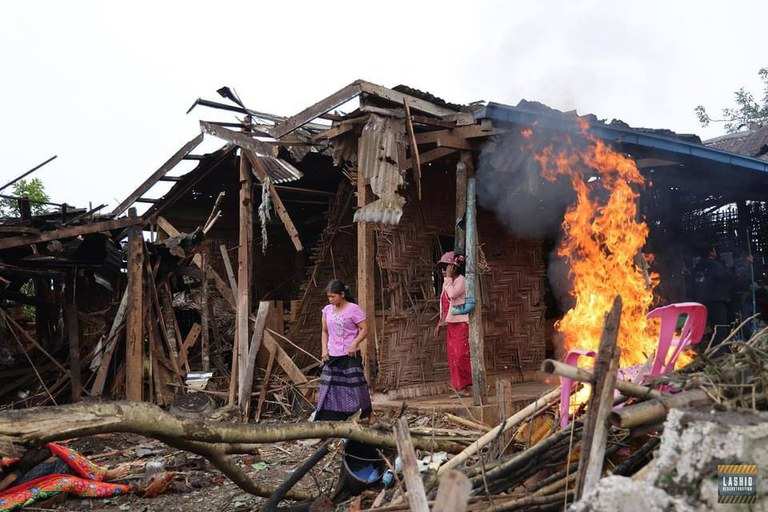
This article was originally published by Radio Free Asia and is reprinted with permission.
An insurgent group battling Myanmar’s junta in Shan state has taken full control of a major town, a spokesperson told Radio Free Asia on Monday.
The Ta’ang National Liberation Army, or TNLA, said it captured the final junta base in Hsipaw on Sunday and plans to use its position to strike other military camps in the area.
The TNLA, is a member of the Three Brotherhood Alliance that launched Operation 1027 nearly a year ago in an effort to seize territory from the military that took power in a 2021 coup.
Since launching the offensive, heavy fighting for control of Lashio, Nawnghkio and other northern Shan towns has sparked concern from China, which borders the state to the east, and forced it to shut previously busy border crossings.
China has tried to protect its interests by brokering ceasefires between the junta and alliance members, but these haven’t lasted long.
The second round of Operation 1027 began when a five-month truce collapsed in June. Since then the TNLA has captured Kyaukme, Mongmit and Nawnghkio towns in northern Shan state, as well as Mandalay region’s Mogoke town.
Two months later, the TNLA turned its sights on Hsipaw. It captured most of the town on Aug. 12 but the junta held on to an infantry camp.
On Sunday, the Infantry Battalion 23 base finally fell to the TNLA, spokesperson Lway Yay Oo said.
“We managed to completely control Hsipaw,” she told RFA. “According to our list, there must be over 50 captured soldiers and over 100 members of military families. We will release the family members.”
Neither side has reported any casualties and RFA’s calls to Shan state’s junta spokesperson Khun Thein Maung went unanswered, as did attempts to reach junta spokesperson Major General Zaw Min Tun.
A political commentator and former military officer suggested that the troops of Infantry Battalion 23 ultimately chose to retreat.
“It is true they were defeated, but it can also be described as a withdrawal,” said the commentator, who spoke on condition of anonymity due to security concerns. “This is because reports indicate that everyone, including the wounded, retreated together.”
By taking full control of Hsipaw the TNLA is in a stronger position to attack nearby junta camps. After capturing most of the town in mid-August it started targeting light infantry battalions 503 and 504 about a kilometer away.
The junta has been hitting back with daily airstrikes. A Y-12 airplane dropped more than 80 bombs on TNLA positions on Friday, the group said in a statement published the following day.
In over two months of fighting in Hsipaw, junta airstrikes and artillery fire have killed 32 people, including young children, and injured 100 more residents, according to local civil society groups.
A resident of Hsipaw told RFA that the threat of junta airstrikes remains a concern, leaving residents fearful of potential air raids.
“When the junta’s troops are present, the fighting intensifies, and heavy weapons land in the city, causing many casualties,” he said. “Without a military camp, there is only one main threat: airstrikes. In the past, I feared both artillery and airplanes, but now, my primary fear is airplanes.”
Lashio under fire
Another Three Brotherhood Alliance member has also been taking territory off junta forces in Shan state. Since the Myanmar National Democratic Alliance Army, or MNDAA, captured the junta’s military headquarters in Lashio in July, and took full control of the town in August, civilians have borne the brunt of junta retaliation through frequent airstrikes and shelling.
Junta bombs killed three villagers on Monday morning in the township’s Ei Naing village, residents said.
Three men in their 40s died and two other people were injured, including a child, according to a resident who didn’t want to be named for fear of reprisals.
“The men who were attacked died on the spot. They didn’t have time to flee because the bomb fell straight on their house,” he said.
The injured were moved to a safe location to receive medical treatment, he added.
The bombs destroyed a church and five houses, according to an MNDAA-associated aid group.
Frequent battles near Ei Naing village prompted heavy shelling by the junta, causing most of the 1,000 people living in the area to flee, residents said.
Many returned to Lashio after the MNDAA took control of the township, but fled again following Monday’s attack.
In September, the MNDAA said it had cut ties with Myanmar’s shadow National Unity Government. It said it would work with China to bring peace and announced it had no plans to capture large towns in Shan state.
Days later the junta bombed Lashio and peace talks never took place.
Since June, over 20 junta airstrikes on Lashio have killed three people and injured over 100, according to an MNDAA statement on Oct. 4.